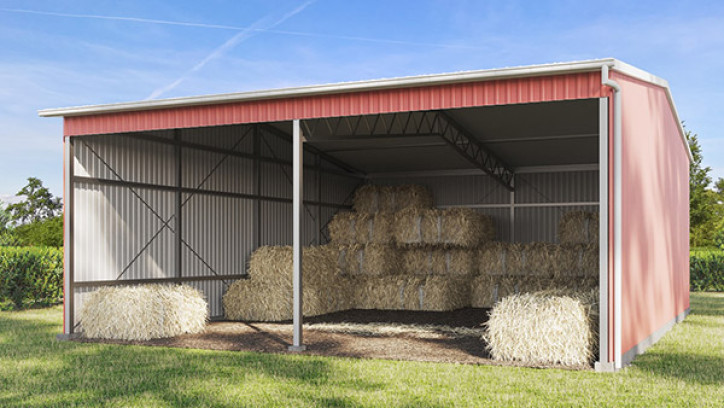2.6. Single-storey pole sheds and hay barns in rural zones – Chartered Professional Engineer

Pole sheds and hay barns can be enclosed, semi-enclosed or open structures which are used for farming activities in rural zones. They commonly house livestock, such as cattle and horses, as well as equipment and fodder, and often grain.
Before you begin, please read the notes for single-storey pole sheds and hay barns (particularly District Plan requirements).
There is no restriction on the type of material used. To use this exemption, an owner must engage a Chartered Professional Engineer (it is best to use a structural engineer) to design or review the hay barn or pole shed as long as the net floor areas does not exceed 110 square metres and the building work is carried out in accordance with the design. Some suppliers and manufacturers of proprietary products have pre-engineered kitsets with a unified sign-off from a Chartered Professional Engineer in which the owner can assemble on their property in accordance with the design. You may need a Licensed Building Practitioner to erect these buildings in accordance with specifications of the Chartered Professional Engineer.
Since the record of undertaken exempted building work might not be available in the council records, any change of use to the buildings involving public access (by the current owner or any prospective purchaser) might create additional risks to the users of the building or other properties.
What is exempt
- A rural farm owner wants to erect a hay barn with a net floor area of 80 square metres and with a maximum height of 3.6 metres. The proposed barn will be located 5 metres from the existing farm house. The local council maps classify the site as a high wind zone. The owner wants to purchase a pre-engineered kitset which has design sign off from a Chartered Professional Engineer and it is intended that the building work will be carried out in accordance with that design.
What needs consent
- An owner of a farm in a rural zone wants to build a pole shed with a net floor area of 135 square metres. A building consent is required because the net floor area exceeds 110 square metres.
- An owner of a farm in a rural zone wants to build a pole shed with a net floor area of 100 square metres to store small agricultural equipment. The building site is in an extra high wind zone. A building consent is required because the wind zone exceeds a "high" rating.
- An owner of a farm in a rural zone wants to build a pole shed with a net floor area of 100 square metres to store some agrichemical, solvents or similar products which are hazardous substances according to the Health and Safety at Work (Hazardous Substances) Regulations 2017. A building consent is required because the hazardous substances can create significant risk and are outside the scope of this exemption.
What the law says
49. Single-storey pole sheds and hay barns
1. Building work in connection with a pole shed or hay barn in a rural zone if—
(a). the building is not more than 1 storey (being a floor level of up to 1 metre above the supporting ground and a height of up to 4 metres above the floor level); and
(b). the building does not exceed 110 square metres in floor area; and
(c). the maximum unsupported roof span in any direction does not exceed 6 metres; and
(d). the building is not accessible by the public; and
(e). the building is not used to store hazardous substances within the meaning of that term in regulation 4 of the Health and Safety at Work (Hazardous Substances) Regulations 2017; and
(f). either—
(i). the design wind speeds do not exceed 44 metres per second (calculated using Verification Method B1/VM1); or
(ii). the building is located in a wind zone no greater than high (as defined in Acceptable Solution B1/AS1).
2. However, subclause (1) does not include any building work in connection with a building that is closer than the measure of its own height to any residential building, public road, railway, or legal boundary.